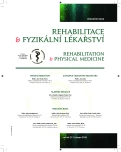Our Experiences with the Examination of the Respiratory Muscles for the Needs of Clinical Rehabilitation Medicine
Authors:
A. Kubincová 1; P. Takáč 1; Ľ. Legáth 2; S. Perečinský 2
Authors‘ workplace:
Klinika fyziatrie, balneológie a liečebnej rehabilitácie Lekárskej fakulty UPJŠ a Univerzitnej nemocnice L. Pasteura, Košice
prednosta doc. MUDr. P. Takáč, Ph. D., mim. prof.
1; Klinika pracovného lekárstva a klinickej toxikológie, rehabilitácie Lekárskej fakulty UPJŠ a Univerzitnej nemocnice L. Pasteura, Košice
prednosta doc. MUDr. Ľ. Legáth, Ph. D.
2
Published in:
Rehabil. fyz. Lék., 23, 2016, No. 1, pp. 24-28.
Category:
Original Papers
Overview
Objective:
To assess the relationship between respiratory muscle function the occlusion pressure measuring and standard functional spirometric parameters.
Group of patients:
Fifty one patients fulfilling the criteria for the diagnosis of pulmonary silicosis.
Methods:
The evaluation of respiratory muscle strength based on occlusion the pressure measurement. Mouth occlusion pressure at 0.1 s inspiration (P0.1), respiratory capacity (P0.1 /Pimax) and standard spirometric parameters has been measured.
Results:
We found significant relationships between parameters of mouth occlusion pressure 0.1 s after the onset of inspiration (P0.1), respiratory capacity (P0.1/PImax) and spirometric parameters such as % VC, FEV1 and FEV1%.
Conclusion:
Based on our findings we suggest a wider use of measurement the occlusion pressure in all areas of clinical medicine where it is needed the objectification of respiratory muscles function including rehabilitation medicine.
Keywords:
mouth occlusion pressure, pulmonary function tests, pulmonary rehabilitation
Sources
1. ATS/ERS (American Thoracic Society and European Respiratory Society): Statement on Respiratory Muscle Testing. Am. J. Respir. Crit. Care Med., 166, 2002, s. 518-624.
2. CLUZEL, P., SIMILOWSKU, T., CHARTRAND-LEFEBVRE, C. et al.: Diaphragm and ChestWall: Assessment of the InspiratoryPump with MR Imaging - Preliminary boservations1. Radiology, 2000, 215, s. 574–583.
3. Donner,C. F., Ambrosino, N., Goldstein, R.: Pulmonary rehabilitation. London, Hodder Arnold, 2005, 405 s., ISBN-l0 - 0 340 810173.
4. CHERNOFF, D., STARK, P.: Magnetic resonance imaging of the thorax. 2014. Literature review current through. [online] citované 05-03-15]. Dostupné na http://www.uptodate .com/contents/ magnetic-resonance-imaging-of-the-thorax.
5. Kabitz, H. J.: Clinical compendium of respiratory muscle testing. Samoa Medical Journal, 1, 2009, 1, s. 20-23.
6. KOLAR, P., SULC, J., KYNCL, M. et al.: Stabilizing function of the diaphragm: dynamic MRI and synchronized spirometric assessment. J. Appl. Physiol., 109, 2010, 4, s. 1064-1071.
7. Lotters, F., van Tol, B., Kwakkel, G. et al.: Effects of controlled inspiratory muscle training in patients with COPD: a meta-analysis. Eur. Respir. J., 20, 2002, s. 570-576.
8. MILLS, G. H., WILD, J. M., EBERLE, B. et al.: Function magnetic resonance imaging of the lung. Br. J. Anaesth., 91, 2003, 1, s. 16-30.
9. Meyer, F. J., Borst, M. M., Zugck, C.: Respiratory muscle dysfunction in congestive heart failure: clinical correlation and prognostic significance. Circulation, 103, 2001, 21, s. 53-58.
10. TROOSTERS. T., GOSSELIK, R., DECRAMET, M.: Respiratory muscle assessment. Eur. Respir. Mon, 31, 2005, s. 57-71.
11. Troosters, T., Remoortel, H. V.: Pulmonary rehabilitation and cardiovascular disease. Semin. Respir. Crit. Care Med., 30, 2009, 6, s. 675-683.
12. Windisch, W., HENNINGS, E., SORICHTER, S. et al.: Peak or plateau maximal inspiratory mouth pressure: which is best? Eur. Respir. J., 23, 2004, s. 708-713.
Labels
Physiotherapist, university degree Rehabilitation Sports medicineArticle was published in
Rehabilitation & Physical Medicine

2016 Issue 1
Most read in this issue
- Decreased Respiratory Muscle Strength – a Possible Reason of Dyspnoea in Patients with Breathing Disorders
- Reliability of the Measurement of Angles in Various Joint Positions: Photogrammetric Software versus Goniometer
- Disorders in Space Perception and Visuospatial Functions in Patients after CMP
- Morbus Huntington – What are the Possibilities of Complex Rehabilitation?
